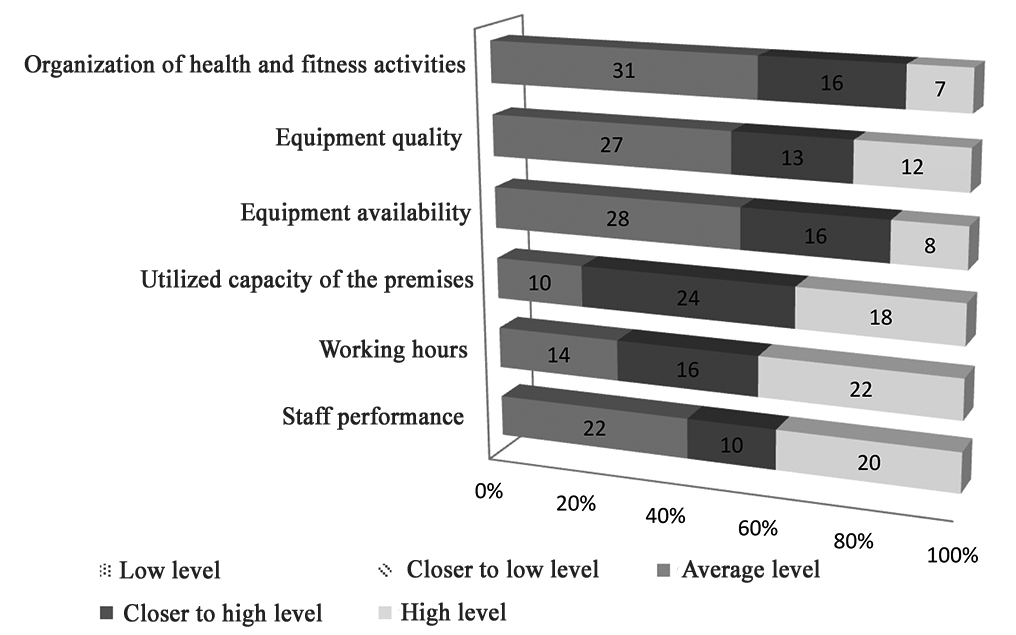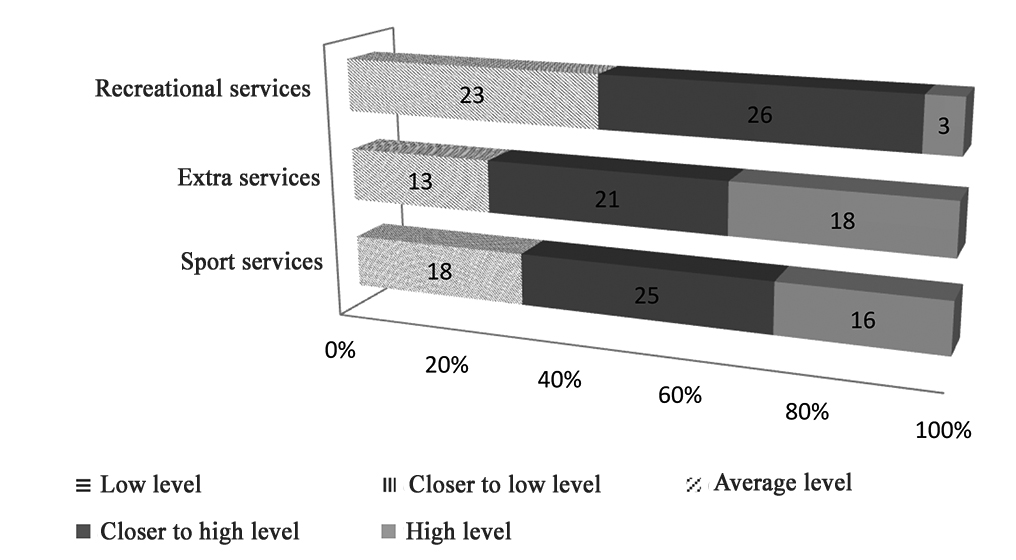Competitiveness of autonomous sport establishments
Фотографии:
ˑ:
Postgraduate M.A. Rodionova
Surgut State University, Surgut
Keywords: autonomous sport establishments, competitiveness, clients.
Introduction. Competitiveness of any organization is the most important factor reflecting the demand for its services and its success in the market in socio-economic conditions of today. O.N. Stepanova notes that “with market relations gaining a foothold, competition becomes an integral part of national health and fitness organizations’ business culture.
At the same time, not only commercial organizations providing health and fitness services at a charge, but also sports facilities wholly or partially financed from budgets of various levels compete for clients. In the context of funding constraints municipal establishments find it more difficult to provide services that would meet the consumers' requirements. Thus, there is a contradiction between the need for sport establishments to meet the market requirements and be competitive and limited resources, first of all financial, to fulfill these requirements.
Objective of the study was to assess the competitiveness of autonomous sport establishments in the market of health and fitness services.
Methods and structure of the study. The study was conducted in the Youth Sports School in the town of Pokachi in May-June 2016. Fifty-two persons aged 15-50 years participated in the survey of customer satisfaction with the quality of services provided by a health and fitness establishment.
Study results and discussion. In response to reduced financing the budget deficit of sport establishments can be compensated for by funds from entrepreneurial and other profit-generating activities and by rendering additional paid services in excess of the municipal tasks. Such an opportunity is provided to all budgetary institutions, but autonomous ones have more rights and possibilities to use economic and managerial potential from provided paid services [1]. The ongoing reforms to ensure the transition of social institutions using a variety of autonomous institutional and legal formats implies the following problems being solved in the process: first, a competitive environment will be created on the national market of municipal services based on the public-private partnerships (PPP); second, the budgeting requirements of the establishments should be reduced since the growing demand for additional services may help the establishments make extra profits and allocate them in the service competitiveness building and service range expansion initiatives. Potential competitive advantages of sport establishments, among which some authors name “advantage in skill” and “advantage in resources”, make the service competitive [2]. Since, as noted earlier, sport establishments are limited in resources, especially financial ones, skill remains the main competitive advantage for such establishments. O.N. Stepanova notes that “unlike the material goods market, health and fitness services improvement may not require significant investments, and innovations can be implemented in the service rendering process in a fairly short time. For example, services improvement by means of using various interesting and unconventional exercises (including those from other sports), musical accompaniment of the classes, enhancement of the trainer’s performance (attention and goodwill towards clients, qualitative demonstration of exercises, individual approach), etc. do not require any additional investments.” [4]. In other words, only by improving the forms and methods of rendering health and fitness services, providing the consumer with qualitative services that meet his needs, the establishment can become popular and competitive in the market. In this aspect, the experience of implementing club forms of classes into the operation of municipal sport establishments is of interest [3].
The state authorities have direct concern in providing the population with competitive services. For example, by Order of the Physical Culture and Sport Department of the Khanty-Mansi Autonomous District № 138 as of May 20, 2016 the health and fitness services content and quality monitoring system in the district was approved.
A survey of customer satisfaction with the quality of services provided at a health and fitness establishment was conducted within the framework of the competition development monitoring in the autonomous district market of sport and fitness. 52 trainees of the Youth Sports School in the town of Pokachi aged 15-50 years were surveyed. First of all, they were asked to rate the quality of service in the sport establishment by such parameters as staff performance, working hours and utilized capacity of the premises, quality and availability of special training equipment and health and fitness activities organization quality. The distribution of the respondents’ answers on a scale from “low” to “high” service quality is shown in Figure 1.

Figure 1. Indicators of customer satisfaction with the quality of services in the sport establishment
It is noteworthy that most of the clients rated the service quality high and above average. At the same time the utilized capacity of the premises, according to the clients, is above average, the quality of health and fitness activities organization is average, and the working hours of the establishment satisfy its clients more than all the other parameters.
Satisfaction with the prices of the services rendered was assessed separately for three types of services: sports, extra and recreational. Indicators of customer satisfaction with the prices of rendered services are shown in Figure 2.

Figure 2. Indicators of customer satisfaction with the prices of services rendered in the sport establishment
The customers rated the price of recreational services as average and above average, that of sports services – as above average, and the price of additional services was considered inflated by 40% of the respondents.
Thus, despite the fact that the majority of the respondents rated the quality of services rendered in the establishment as above average, the price of additional services did not correspond to their quality. According to the respondents, the service quality may be negatively affected by the poor financial and technological situations of the service establishments.
Conclusion. Competitiveness of fitness and sports services should be understood as a combination of qualitative and price characteristics that guarantee satisfaction of the needs of sport establishments’ clients. The findings of the study should become the basis for improving the quality of services rendered to the population, which in the end will increase the competitiveness of municipal autonomous sport establishments.
References
- Bekulov Kh.M., Kanokova B.A. Puti effektivnogo upravleniya gosudarstvennym i munitsipalnym imushchestvom v avtonomnykh uchrezhdeniyakh [Ways of effective public and municipal property management in autonomous institutions]. Mater. V Mezhdunar. nauch.-prakt. konf. "Sovremennaya nauka: tendentsii razvitiya" [Proc. V Intern. res.-pract. conf. "Modern science: development trends"]. 2013, vol. II, Krasnodar, 2013, 172 p.
- Durovich A.P. Marketingovye issledovaniya v turizme. Ucheb. posobie [Marketing research in tourism. Study guide]. St. Petersburg: Piter publ., 2008, 384 p.
- Rodionov M.A. Optimizatsiya deyatelnosti munitsipalnykh uchrezhdeniy sportivnoy napravlennosti [Optimization of activity of municipal sports facilities]. Teoriya i praktika fiz. kultury, 2016, no. 10, p. 55.
- Stepanova O.N. Metodika otsenki konkurentosposobnosti fizkulturno-sportivnykh uslug [Techniques to estimate competitiveness of health and fitness services]. Teoriya i praktika fiz. kultury, 2004, no. 11, p. 63.
- Stepanova O.N., Makhov A.S. Marketingovoe obespechenie deyatelnosti sportivno-ozdorovitelnogo kluba [Marketing support of fitness club operation]. Marketing, 2010, no. 5, pp. 63-72.
Corresponding author: rodionovam2007@yandex.ru
Abstract
The ongoing reforms to ensure the transition of social institutions using a variety of autonomous institutional and legal formats implies the following problems being solved in the process: first, a competitive environment will be created on the national market of municipal services based on the public-private partnerships (PPP); second, the budgeting requirements of the institutions should be reduced since the growing demand for additional services may help the institutions make extra profits and allocate them in the service competitiveness building and service range expansion initiatives. The article considers the potential competitive advantages of autonomous sport establishments versus commercial sport service businesses. We rated the client satisfaction with the quality of the services provided by the health and fitness establishments versus the service prices. Most of the respondents rated the service quality “above average” with the additional services rated as “worth their money”. The respondents also believed that the service quality may be negatively affected by the poor financial and technological situations of the service establishments.



